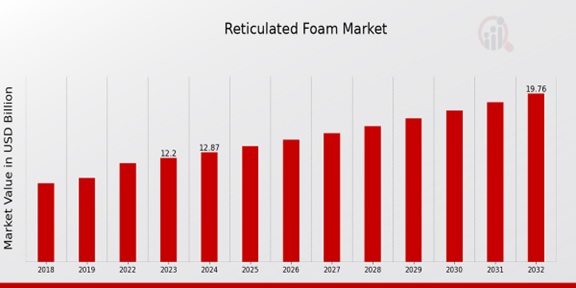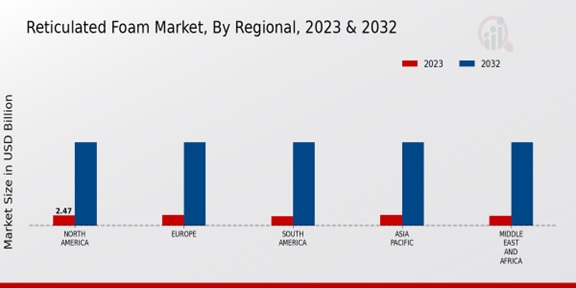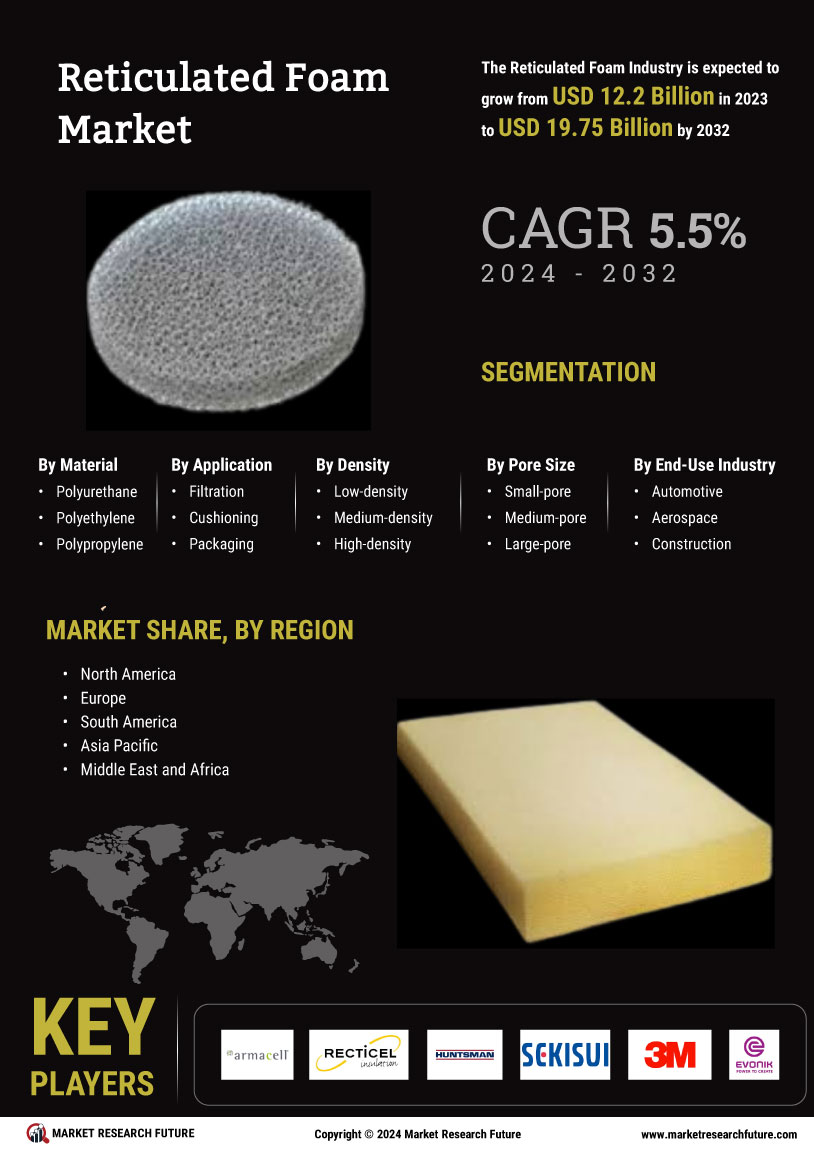Global Reticulated Foam Market Overview
The Reticulated Foam Market Size was estimated at USD 13.59 Billion in 2024. The Reticulated Foam Industry is expected to grow from USD 14.34 Billion in 2025 to USD 23.26 Billion by 2034. exhibiting a compound annual growth rate (CAGR) of 5.5% during the forecast period (2025 - 2034).
Key Reticulated Foam Market Trends Highlighted
The Reticulated Foam Market is driven by its unique properties, such as its high porosity, flexibility, and resistance to chemicals and heat. The increasing use of these foams in various industries, including automotive, aerospace, and healthcare, is propelling market growth. Moreover, the rising demand for lightweight and durable materials in these sectors is fueling the adoption of reticulated foams.
Key market opportunities lie in the expansion of the electric vehicle industry, where reticulated foams are used in battery systems for thermal management and vibration damping. Additionally, the growing focus on sustainable and environmentally friendly materials is creating opportunities for the use of reticulated foams made from recycled or bio-based materials.
Recent trends in the reticulated foam market include the advent of advanced manufacturing techniques that enhance foam performance and reduce production costs. Additionally, the development of new foam formulations with tailored properties for specific applications is opening up new avenues for growth. The market is also witnessing a shift towards the use of digital tools and simulations to optimize foam design and performance, leading to improved product quality and efficiency.

Source: Primary Research, Secondary Research, MRFR Database and Analyst Review
Reticulated Foam Market Drivers
-
Rising Demand for Reticulated Foam in Aerospace and Defense Applications
Reticulated foam has been increasingly adopted in the aerospace and defense spaces, as it offers several unique features, including its lightweight, high strength-to-weight ratio, and energy absorption capabilities, Berenschot. In the aerospace industry, this foam material is used in aircraft interiors, seating, and soundproofing, among other applications. Particularly, as it is lighter than conventional foam materials, it will reduce fuel consumption and carbon dioxide emissions, thereby making it a favorable material for aircraft manufacturers.Moreover, as aircraft structures compress in accidents, the energy-absorbing foam can reduce the fatalities sustained by aircraft passengers by effectively absorbing the energy that results from contact with the ground or any other structure at the time of an aircraft crash, as seen in the National Aeronautics and Space Administration. In the defense industries, the foam can also be found in armor for helmets, vests, and shields which protect soldiers by absorbing the energy from a bullet impact or an explosion of a mine.The specialty material is also favored due to its light nature and the ability to breathe even as soldiers remain draped in protective gear for long periods of time. As both the aerospace and defense industries grow and the demand for lighter protective material increases, the future market for reticulated foam in these two industries appears promising.
Increasing Adoption of Reticulated Foam in the Healthcare Industry
Another key growth driver for the reticulated foam market is the healthcare industry. The properties of reticulated foam, which include high porosity, breathability, and fluid absorption capabilities, are ideal for a wide range of medical applications. In the field of wound care, reticulated foam dressings facilitate healing by providing a moist wound environment. The dressings are also easily conformable, which allows for the dressing of complex wounds and can effectively absorb wound exudate.Furthermore, in surgical applications, reticulated foam can help control bleeding during and after surgical procedures as a hemostatic material. Due to its lightweight and cushioning properties, the material is often used in prosthetic limbs, thereby providing comfort and support to amputees.
Growing Use of Reticulated Foam in Automotive Applications
The automotive industry is seeing good traction of reticulated foam due to the necessity of lightweight sound absorbing materials. Specifically, the capability of reticulated foam to absorb sound, along with the capacity to dissipate sound energy, makes reticulated foam a very useful substance to lower noise levels in the vehicle interior. As a result, it is like in headliners as well as door panels and a dash of vehicles, passenger comfort is considerably more due to the acoustic comfort the passengers feel.In addition to these properties, sound absorbing foam is also lightweight in nature allowing far better fuel efficiency and lower emission levels. As a growing number of such vehicles are being manufactured every year, the usage of reticulated foam in the automotive sectors will increase multi-fold in the ensuing years.
Reticulated Foam Market Segment Insights:
Reticulated Foam Market Material Insights
Material segmentation in the Reticulated Foam Market includes Polyurethane, Polyethylene, Polypropylene, and Polystyrene. The Polyurethane segment will take the largest share of the Reticulated Foam Market revenue in 2023 and will continue to dominate through 2028. Pure polyurethane reticulated foam features high strength and durability and is resistant to flames. This material is suitable for filtering, packaging, and upholstering the interior of cars and other vehicles. Polyethylene reticulated foam is flexible and environmentally resistant, suitable for packaging, padding, and thermal insulation.Polypropylene reticulated foam is currently gaining traction on the market, as it is lightweight and impact resistant as well as recyclable. Use for upholstery in cars, molds for peace, and medical devices is common. Polystyrene reticulated foam is the least costly material that is used for cushioning, packaging, and constructive and consumer goods. The provided Reticulated Foam Market segmentation data show the diversity of materials and their unique characteristics to allow manufacturers to cater to the needs of industry specialty.

Source: Primary Research, Secondary Research, MRFR Database and Analyst Review
Reticulated Foam Market Application Insights
The application segment hugely contributes to the development of the Reticulated Foam Market. Filtration, cushioning, packaging, thermal insulation, and acoustic insulation are leading application types promoting the market. In 2023, the filtration application contributed to a major market share due to the demand for air and water purification systems. Growth in the automobile industry and increasing health and fitness awareness further lead to steady growth in cushioning applications. The use of reticulated foam in automotive interiors and sports equipment highly promotes the application.Packaging applications should also contribute to the market. The increasing e-commerce sector and the demand for protective packaging options lead to the situation. Growth in the thermal insulation application is also stimulated by the imposition of strict energy efficiency regulations across the globe. The use of acoustic insulation should be growing at a considerable rate as well, as more and more purchases allow people to completely soundproof floors, walls, ceilings, windows, and doors in residential and commercial premises. In conclusion, it should be stressed that the Reticulated Foam Market has the potential for significant growth in the years to come.Various applications should support the development of this market.
Reticulated Foam Market Density Insights
The Reticulated Foam Market is segmented into low-density, medium-density, and high-density Foam. Low-density Foam is the most common type of reticulated foam and is used in a wide range of applications, including filtration, packaging, and cushioning. Medium-density foam is used in applications where higher strength and durability are required, such as in automotive and aerospace applications. High-density foam is the most durable type of reticulated foam and is used in applications where the highest levels of strength and durability are required, such as in military and defense applications.The Reticulated Foam Market for low-density foam is expected to grow from USD 4.5 billion in 2023 to USD 6.2 billion by 2032 at a CAGR of 4.2%. The Reticulated Foam Market for medium-density foam is expected to grow from USD 3.2 billion in 2023 to USD 4.5 billion by 2032 at a CAGR of 4.8%. The Reticulated Foam Market for high-density Foam is expected to grow from USD 2.1 billion in 2023 to USD 3.1 billion by 2032 at a CAGR of 5.6%.
Reticulated Foam Market Pore Size Insights
The Reticulated Foam Market segmentation by pore size includes small-pore, medium-pore, and large-pore foams. Small-pore foams, with pore sizes less than 10 pores per inch (PPI), offer superior filtration efficiency and are commonly used in air and liquid filtration applications. Medium-pore foams, with pore sizes in the range of 10-60 PPI, strike a balance between filtration efficiency and permeability and find applications in various industries, including automotive and aerospace. Large-pore foams, with pore sizes greater than 60 PPI, prioritize permeability over filtration efficiency and are often employed in applications requiring high airflow, such as cushioning and packaging.The Reticulated Foam Market revenue for the small-pore segment is projected to reach $X billion by 2024, while the medium-pore and large-pore segments are expected to generate revenues of $Y billion and $Z billion, respectively.
Reticulated Foam Market Production Process Insights
The Reticulated Foam Market segmentation by Production Process includes Mechanical frothing and Chemical blowing. Mechanical frothing held the largest market share in 2022 and is expected to continue to lead the market through 2032. The Mechanical frothing segment is projected to reach USD 6.75 billion by 2032, exhibiting a CAGR of 5.2% during the forecast period. The Chemical blowing segment is anticipated to grow at a CAGR of 6.1% during the forecast period and reach a market size of USD 4.25 billion by 2032. The growth of this segment can be attributed to the rising demand for lightweight and durable foams in various end-use industries.
Reticulated Foam Market End-Use Industry Insights
The end-use industry segment plays a crucial role in shaping the Reticulated Foam Market. In 2023, the automotive industry held the largest market share due to the increasing demand for lightweight and durable materials in vehicle manufacturing. The aerospace industry is another major end-use segment, driven by the rising need for advanced materials in aircraft construction. The construction industry also contributes significantly to the market, as reticulated foam is used for insulation, soundproofing, and cushioning in buildings. The medical industry utilizes reticulated foam for applications such as wound care, filtration, and implants.Finally, the consumer electronics industry employs reticulated foam in packaging, cushioning, and soundproofing for electronic devices.
Reticulated Foam Market Regional Insights
The Reticulated Foam Market segmentation by Region reveals diverse market dynamics in key geographies. North America is projected to dominate the market with a significant share, driven by the presence of established automotive and construction industries. Europe follows closely, exhibiting steady growth due to increasing demand for lightweight and energy-efficient materials. The Asia-Pacific region is anticipated to witness the fastest growth rate, fueled by rising construction and infrastructure development in emerging economies like China and India.South America and the Middle East Africa are expected to contribute a smaller share to the global revenue but hold potential for market expansion due to growing industrialization and urbanization. These regional insights provide valuable data for manufacturers and investors to target specific regions for market entry and growth strategies.

Source: Primary Research, Secondary Research, MRFR Database and Analyst Review
Reticulated Foam Market Key Players And Competitive Insights:
Reticulated Foam Market is characterized by the top players continually developing new innovative products. They are also intensively involved in acquiring or partnering with various companies. It is very competitive that players Reticulated foam, such as SEKISUI, INOAC, PAR Group, and Rogers Corporation, differ substantially on the basis of quality, compliance, and technological sophistication, to name a few. However, it does not mean that the current structure will remain in the future, as more companies adopt reticulated foams and more cutting-edge technologies and novel business models are developed.
One of the most notable reticulated foam market players, Owens Corning, specializes in high-quality glass wool insulation, roofing shingles, and fiberglass-based materials and products. The company has a regional division responsible for supplying the reticulated foam market with tons of reticulated foam products every year. Owens Corning is especially committed to innovation and continuous improvement. The firm’s Research and Development Department is doing its best to provide optimal products and tailor them to the exact needs of the company’s discipline and sphere required in today’s world. These continuous efforts allow Owens Corning to remain a top-notch, reliable, and competitive company expected to retain its leading position in the future.
Another vital treasure of the reticulated foam market is Recticel – the Belgian multinational specializing in rigid polyurethane and polyisocyanurate foams. The company aims to serve a wide array of industries Trillick Works Common Road Bdoo8, including packaging, automotive, construction, and bedding. Recticel is famous for the world’s largest blocks of foam and many other unique solutions. The company aims to become a more sustainable business while encouraging innovative thinking and growing further. Specialties include foam production, technological solutions, and compliance.
Key Companies in the Reticulated Foam Market Include:
- Armacell
- Recticel
- Huntsman International
- Sekisui Chemical
- 3M
- JSP Corporation
- Evonik
- BASF
- The Dow Chemical Company
- Saint-Gobain
- Lydall
- Trexel
- Poron
- Rogers Corporation
Reticulated Foam Market Industry Developments
The Reticulated Foam Market is projected to reach USD 23.26 billion by 2034, exhibiting a CAGR of 5.5% during the forecast period (2025-2034). Growing demand from the automotive and aerospace industries, coupled with increasing use in packaging and filtration applications, is driving market growth.Recent developments include the launch of new products, such as BASF's Cellasto and Armacell's ArmaForm, which offer improved performance and durability. Additionally, strategic partnerships and acquisitions are shaping the market landscape. For instance, in 2023, Recticel acquired Aliplast to strengthen its position in the European market.
Reticulated Foam Market Segmentation Insights
Reticulated Foam Market Material Outlook
Reticulated Foam Market Application Outlook
- Filtration
- Cushioning
- Packaging
- Thermal insulation
- Acoustic insulation
Reticulated Foam Market Density Outlook
- Low-density
- Medium-density
- High-density
Reticulated Foam Market Pore Size Outlook
- Small-pore
- Medium-pore
- Large-pore
Reticulated Foam Market Production Process Outlook
- Mechanical frothing
- Chemical blowing
Reticulated Foam Market End-Use Industry Outlook
- Automotive
- Aerospace
- Construction
- Medical
- Consumer electronics
Reticulated Foam Market Regional Outlook
- North America
- Europe
- South America
- Asia Pacific
- Middle East and Africa
| Report Attribute/Metric |
Details |
| Market Size 2024 |
13.59 (USD Billion) |
| Market Size 2025 |
14.34 (USD Billion) |
| Market Size 2034 |
23.26 (USD Billion) |
| Compound Annual Growth Rate (CAGR) |
5.5% (2025 - 2034) |
| Report Coverage |
Revenue Forecast, Competitive Landscape, Growth Factors, and Trends |
| Base Year |
2024 |
| Market Forecast Period |
2025 - 2034 |
| Historical Data |
2020 - 2024 |
| Market Forecast Units |
USD Billion |
| Key Companies Profiled |
Armacell, Recticel, Huntsman International, Sekisui Chemical,3M, JSP Corporation, Evonik, BASF, The Dow Chemical Company, Saint-Gobain, Lydall, Trexel, Poron, Rogers Corporation |
| Segments Covered |
Material, Application, Density, Pore Size, Production Process, End-Use Industry, Regional |
| Key Market Opportunities |
High demand in filtration and fluid management applications Growing use in aerospace, medical and automotive industries Expansion of applications in packaging and construction Rising demand for lightweight and durable materials Technological advancements in production and design |
| Key Market Dynamics |
Rising Demand for Thermal Insulation Growing Aerospace and Defense sector Increasing Applications in Healthcare Focus on Energy Efficiency Advancements in Production Technology |
| Countries Covered |
North America, Europe, APAC, South America, MEA |
Frequently Asked Questions (FAQ) :
The Reticulated Foam Market is currently valued at USD 13.59 Billion in 2024.
The Reticulated Foam Market is projected to reach USD 23.26 Billion by 2034, exhibiting a CAGR of 5.5% during the forecast period 2025-2034.
Asia-Pacific is expected to dominate the Reticulated Foam Market throughout the forecast period, owing to the increasing demand from the automotive, construction, and packaging industries in the Region.
Reticulated foam finds applications in various industries, including automotive (acoustic insulation, seat cushioning), construction (insulation, soundproofing), packaging (protective packaging, cushioning), and filtration (air and liquid filtration).
Some of the prominent players in the Reticulated Foam Market include BASF, Recticel, Armacell, Rogers Corporation, and Zotefoams.
The growth of the Reticulated Foam Market is attributed to factors such as rising demand for lightweight and energy-efficient materials, increasing construction activities, and growing awareness about thermal insulation and soundproofing.
The Reticulated Foam Market faces challenges related to raw material price fluctuations, competition from alternative materials, and stringent environmental regulations.
Opportunities in the Reticulated Foam Market lie in the development of innovative products, expansion into emerging markets, and collaborations with end-use industries.
The COVID-19 pandemic had a moderate impact on the Reticulated Foam Market, causing temporary disruptions in supply chains and demand from certain industries. However, the market is expected to recover in the post-pandemic period.
Key trends in the Reticulated Foam Market include the adoption of sustainable and eco-friendly materials, advancements in manufacturing processes, and the development of multifunctional foams with enhanced properties.

















